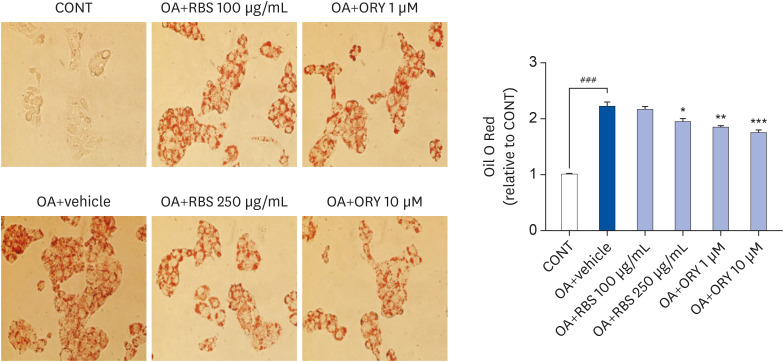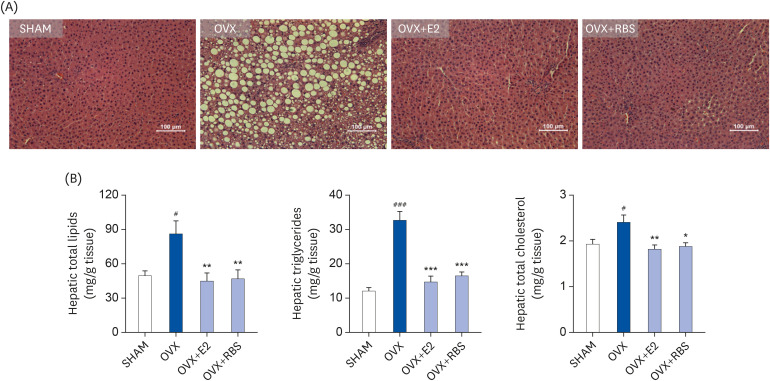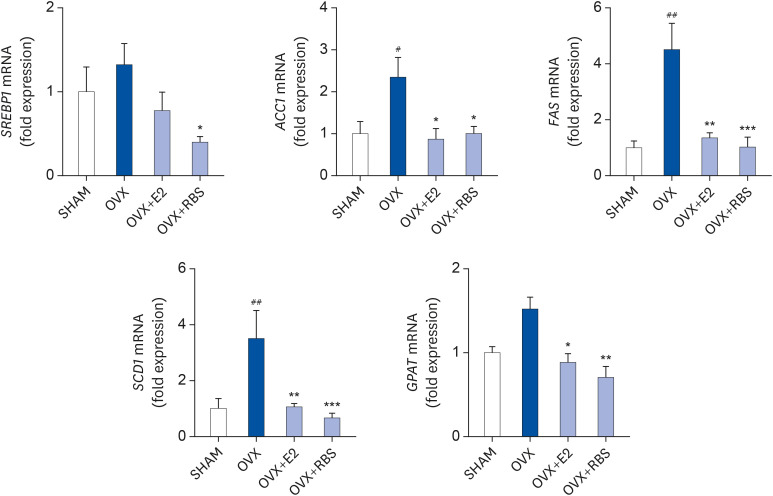Nutr Res Pract.
2020 Dec;14(6):568-579. 10.4162/nrp.2020.14.6.568.
Standardized rice bran extract improves hepatic steatosis in HepG2 cells and ovariectomized rats
- Affiliations
-
- 1Research Division of Food Functionality, Korea Food Research Institute, Wanju 55365, Korea
- 2Division of Food Biotechnology, University of Science & Technology, Daejeon 34113, Korea
- 3Technical Assistance Center, Korea Food Research Institute, Wanju 55365, Korea
- 4S&D Research and Development Institute, Cheongju 28156, Korea
- 5Department of Food Science and Technology, Pukyong National University, Busan 48513, Korea
- KMID: 2508791
- DOI: http://doi.org/10.4162/nrp.2020.14.6.568
Abstract
- BACKGROUD/OBJECTIVES: Hepatic steatosis is the most common liver disorder, particularly in postmenopausal women. This study investigated the protective effects of standardized rice bran extract (RBS) on ovariectomized (OVX)-induced hepatic steatosis in rats.
MATERIALS/METHODS
HepG2 cells were incubated with 200 µM oleic acid to induce lipid accumulation with or without RBS and γ-oryzanol. OVX rats were separated into three groups and fed a normal diet (ND) or the ND containing 17β-estradiol (E2; 10 µg/kg) and RBS (500 mg/kg) for 16 weeks.
RESULTS
RBS supplementation improved serum triglyceride and free fatty acid levels in OVX rats. Histological analysis showed that RBS significantly attenuated hepatic fat accumulation and decreased hepatic lipid, total cholesterol, and triglyceride levels. Additionally, RBS suppressed the estrogen deficiency-induced upregulation of lipogenic genes, such as sterol regulatory element-binding protein 1 (SREBP1), acetyl-CoA carboxylase 1, fatty acid synthase, glycerol-3-phosphate acyltransferase, and stearoyl-CoA desaturase 1.
CONCLUSIONS
RBS and γ-oryzanol effectively reduced lipid accumulation in a HepG2 cell hepatic steatosis model. RBS improves OVX-induced hepatic steatosis by regulating the SREBP1-mediated activation of lipogenic genes, suggesting the benefits of RBS in preventing fatty liver in postmenopausal women.
Keyword
Figure
Reference
-
1. Farrell GC, Larter CZ. Nonalcoholic fatty liver disease: from steatosis to cirrhosis. Hepatology. 2006; 43:S99–S112. PMID: 16447287.
Article2. Singh A, Le P, Lopez R, Alkhouri N. The utility of noninvasive scores in assessing the prevalence of nonalcoholic fatty liver disease and advanced fibrosis in type 1 diabetic patients. Hepatol Int. 2018; 12:37–43. PMID: 29318450.
Article3. Fan JG, Kim SU, Wong VW. New trends on obesity and NAFLD in Asia. J Hepatol. 2017; 67:862–873. PMID: 28642059.
Article4. Summart U, Thinkhamrop B, Chamadol N, Khuntikeo N, Songthamwat M, Kim CS. Gender differences in the prevalence of nonalcoholic fatty liver disease in the Northeast of Thailand: a population-based cross-sectional study. F1000 Res. 2017; 6:1630.
Article5. Fu X, Xing L, Xu W, Shu J. Treatment with estrogen protects against ovariectomy-induced hepatic steatosis by increasing AQP7 expression. Mol Med Rep. 2016; 14:425–431. PMID: 27176782.
Article6. Gualtieri M, Cahoon SS, Paulson RJ, Shoupe D, Muderspach LI, Roman LD, Matsuo K. Surgical menopause and the increased risk of non-alcoholic fatty liver disease in patients with endometrial hyperplasia and cancer. Fertil Steril. 2015; 103:e23.
Article7. Walsh BW, Schiff I, Rosner B, Greenberg L, Ravnikar V, Sacks FM. Effects of postmenopausal estrogen replacement on the concentrations and metabolism of plasma lipoproteins. N Engl J Med. 1991; 325:1196–1204. PMID: 1922206.
Article8. Mabunga DF, Gonzales EL, Kim HJ, Choung SY. Treatment of GABA from fermented rice germ ameliorates caffeine-induced sleep disturbance in mice. Biomol Ther (Seoul). 2015; 23:268–274. PMID: 25995826.
Article9. Wani AA, Singh P, Shah MA, Schweiggert-Weisz U, Gul K, Wani IA. Rice starch diversity: effects on structural, morphological, thermal, and physicochemical properties-a review. Compr Rev Food Sci Food Saf. 2012; 11:417–436.
Article10. Laokuldilok T, Shoemaker CF, Jongkaewwattana S, Tulyathan V. Antioxidants and antioxidant activity of several pigmented rice brans. J Agric Food Chem. 2011; 59:193–199. PMID: 21141962.
Article11. Kahlon TS, Chow FI, Sayre RN, Betschart AA. Cholesterol-lowering in hamsters fed rice bran at various levels, defatted rice bran and rice bran oil. J Nutr. 1992; 122:513–519. PMID: 1311755.
Article12. Rhee YH, Rhee CH, Chung PS, Ahn JC. Anti-oxidant and anti-inflammatory effects of rice bran and green tea fermentation mixture on lipopolysaccharide-induced RAW 264.7 macrophages. Trop J Pharm Res. 2017; 16:2943–2951.
Article13. Nie Y, Luo F, Wang L, Yang T, Shi L, Li X, Shen J, Xu W, Guo T, Lin Q. Anti-hyperlipidemic effect of rice bran polysaccharide and its potential mechanism in high-fat diet mice. Food Funct. 2017; 8:4028–4041. PMID: 28869259.
Article14. Qureshi AA, Sami SA, Khan FA. Effects of stabilized rice bran, its soluble and fiber fractions on blood glucose levels and serum lipid parameters in humans with diabetes mellitus types I and II. J Nutr Biochem. 2002; 13:175–187. PMID: 11893482.
Article15. Cheng HH, Huang HY, Chen YY, Huang CL, Chang CJ, Chen HL, Lai MH. Ameliorative effects of stabilized rice bran on type 2 diabetes patients. Ann Nutr Metab. 2010; 56:45–51. PMID: 20016147.
Article16. Muhammad SI, Maznah I, Mahmud R, Zuki AB, Imam MU. Upregulation of genes related to bone formation by γ-amino butyric acid and γ-oryzanol in germinated brown rice is via the activation of GABAB-receptors and reduction of serum IL-6 in rats. Clin Interv Aging. 2013; 8:1259–1271. PMID: 24098073.17. Mastinu A, Bonini SA, Rungratanawanich W, Aria F, Marziano M, Maccarinelli G, Abate G, Premoli M, Memo M, Uberti D. Gamma-oryzanol prevents LPS-induced brain inflammation and cognitive impairment in adult mice. Nutrients. 2019; 11:728.
Article18. Høegh-Andersen P, Tankó LB, Andersen TL, Lundberg CV, Mo JA, Heegaard AM, Delaissé JM, Christgau S. Ovariectomized rats as a model of postmenopausal osteoarthritis: validation and application. Arthritis Res Ther. 2004; 6:R169–80. PMID: 15059281.19. Yang H, Yoon M, Um MY, Lee J, Jung J, Lee C, Kim YT, Kwon S, Kim B, Cho S. Sleep-promoting effects and possible mechanisms of action associated with a standardized rice bran supplement. Nutrients. 2017; 9:512.
Article20. Um MY, Kim S, Jin YH, Yoon M, Yang H, Lee J, Jung J, Urade Y, Huang ZL, Kwon S, Cho S. A novel neurological function of rice bran: a standardized rice bran supplement promotes non-rapid eye movement sleep in mice through histamine H1 receptors. Mol Nutr Food Res. 2017; 61:1700316.21. Um MY, Yang H, Han JK, Kim JY, Kang SW, Yoon M, Kwon S, Cho S. Rice bran extract supplement improves sleep efficiency and sleep onset in adults with sleep disturbance: a randomized, double-blind, placebo-controlled, polysomnographic study. Sci Rep. 2019; 9:12339. PMID: 31451704.
Article22. Lim DW, Kim JG, Kim YT. Effects of dietary isoflavones from Puerariae radix on lipid and bone metabolism in ovariectomized rats. Nutrients. 2013; 5:2734–2746. PMID: 23867712.
Article23. Lim DW, Kim YT. Anti-osteoporotic effects of Angelica sinensis (Oliv.) Diels extract on ovariectomized rats and its oral toxicity in rats. Nutrients. 2014; 6:4362–4372. PMID: 25325255.24. Folch J, Lees M, Sloane Stanley GH. A simple method for the isolation and purification of total lipides from animal tissues. J Biol Chem. 1957; 226:497–509. PMID: 13428781.
Article25. Sawada K, Rahmania H, Matsuki M, Hashimoto H, Ito J, Miyazawa T, Nakagawa K. Absorption and metabolism of γ-oryzanol, a characteristic functional ingredient in rice bran. J Nutr Sci Vitaminol (Tokyo). 2019; 65:S180–4. PMID: 31619625.
Article26. Jones ME, Thorburn AW, Britt KL, Hewitt KN, Wreford NG, Proietto J, Oz OK, Leury BJ, Robertson KM, Yao S, Simpson ER. Aromatase-deficient (ArKO) mice have a phenotype of increased adiposity. Proc Natl Acad Sci U S A. 2000; 97:12735–12740. PMID: 11070087.
Article27. Weigt C, Hertrampf T, Flenker U, Hülsemann F, Kurnaz P, Fritzemeier KH, Diel P. Effects of estradiol, estrogen receptor subtype-selective agonists and genistein on glucose metabolism in leptin resistant female Zucker diabetic fatty (ZDF) rats. J Steroid Biochem Mol Biol. 2015; 154:12–22. PMID: 26134426.
Article28. Heine PA, Taylor JA, Iwamoto GA, Lubahn DB, Cooke PS. Increased adipose tissue in male and female estrogen receptor-alpha knockout mice. Proc Natl Acad Sci U S A. 2000; 97:12729–12734. PMID: 11070086.
Article29. Lavoie JM, Pighon A. NAFLD, estrogens, and physical exercise: the animal model. J Nutr Metab. 2012; 2012:914938. PMID: 21845221.
Article30. Oliveira MC, Campos-Shimada LB, Marçal-Natali MR, Ishii-Iwamoto EL, Salgueiro-Pagadigorria CL. A long-term estrogen deficiency in ovariectomized mice is associated with disturbances in fatty acid oxidation and oxidative stress. Rev Bras Ginecol Obstet. 2018; 40:251–259. PMID: 29913542.
Article31. Campos LB, Gilglioni EH, Garcia RF, Brito MN, Natali MR, Ishii-Iwamoto EL, Salgueiro-Pagadigorria CL. Cimicifuga racemosa impairs fatty acid β-oxidation and induces oxidative stress in livers of ovariectomized rats with renovascular hypertension. Free Radic Biol Med. 2012; 53:680–689. PMID: 22684021.32. Charatcharoenwitthaya P, Lindor KD, Angulo P. The spontaneous course of liver enzymes and its correlation in nonalcoholic fatty liver disease. Dig Dis Sci. 2012; 57:1925–1931. PMID: 22373863.
Article33. Chong CL, Hussan F, Othman F. Hepatoprotective effects of Morinda citrifolia leaf extract on ovariectomized rats fed with thermoxidized palm oil diet: evidence at histological and ultrastructural level. Oxid Med Cell Longev. 2019; 2019:9714302. PMID: 31827717.34. Koshy SM, Bobby Z, Jacob SE, Ananthanarayanan PH, Sridhar MG, Paulose DT. Amla prevents fructose-induced hepatic steatosis in ovariectomized rats: role of liver FXR and LXRα. Climacteric. 2015; 18:299–310. PMID: 24940994.
Article35. Watanabe M, Houten SM, Wang L, Moschetta A, Mangelsdorf DJ, Heyman RA, Moore DD, Auwerx J. Bile acids lower triglyceride levels via a pathway involving FXR, SHP, and SREBP-1c. J Clin Invest. 2004; 113:1408–1418. PMID: 15146238.
Article36. Kohjima M, Enjoji M, Higuchi N, Kato M, Kotoh K, Yoshimoto T, Fujino T, Yada M, Yada R, Harada N, Takayanagi R, Nakamuta M. Re-evaluation of fatty acid metabolism-related gene expression in nonalcoholic fatty liver disease. Int J Mol Med. 2007; 20:351–358. PMID: 17671740.
Article37. Flowers MT, Ntambi JM. Role of stearoyl-coenzyme A desaturase in regulating lipid metabolism. Curr Opin Lipidol. 2008; 19:248–256. PMID: 18460915.
Article38. Kotronen A, Seppänen-Laakso T, Westerbacka J, Kiviluoto T, Arola J, Ruskeepää AL, Oresic M, Yki-Järvinen H. Hepatic stearoyl-CoA desaturase (SCD)-1 activity and diacylglycerol but not ceramide concentrations are increased in the nonalcoholic human fatty liver. Diabetes. 2009; 58:203–208. PMID: 18952834.
Article39. Cao J, Li JL, Li D, Tobin JF, Gimeno RE. Molecular identification of microsomal acyl-CoA:glycerol-3-phosphate acyltransferase, a key enzyme in de novo triacylglycerol synthesis. Proc Natl Acad Sci U S A. 2006; 103:19695–19700. PMID: 17170135.40. Thuresson ER. Inhibition of glycerol-3-phosphate acyltransferase as a potential treatment for insulin resistance and type 2 diabetes. Curr Opin Investig Drugs. 2004; 5:411–418.41. Panneerselvam S, Packirisamy RM, Bobby Z, Elizabeth Jacob S, Sridhar MG. Soy isoflavones (Glycine max) ameliorate hypertriglyceridemia and hepatic steatosis in high fat-fed ovariectomized Wistar rats (an experimental model of postmenopausal obesity). J Nutr Biochem. 2016; 38:57–69. PMID: 27723468.42. Kamei Y, Suzuki M, Miyazaki H, Tsuboyama-Kasaoka N, Wu J, Ishimi Y, Ezaki O. Ovariectomy in mice decreases lipid metabolism-related gene expression in adipose tissue and skeletal muscle with increased body fat. J Nutr Sci Vitaminol (Tokyo). 2005; 51:110–117. PMID: 16022198.
Article43. Hao CL, Lin HL, Ke LY, Yen HW, Shen KP. Pre-germinated brown rice extract ameliorates high-fat diet-induced metabolic syndrome. J Food Biochem. 2019; 43:e12769. PMID: 31353547.
Article44. Perez-Ternero C, Claro C, Parrado J, Herrera MD, Alvarez de Sotomayor M. Rice bran enzymatic extract reduces atherosclerotic plaque development and steatosis in high-fat fed ApoE−/− mice. Nutrition. 2017; 37:22–29. PMID: 28359358.45. Jung TD, Shin GH, Kim JM, Choi SI, Lee JH, Lee SJ, Park SJ, Woo KS, Oh SK, Lee OH. Comparative analysis of γ-oryzanol, β-glucan, total phenolic content and antioxidant activity in fermented rice bran of different varieties. Nutrients. 2017; 9:571.
Article46. Justo ML, Rodriguez-Rodriguez R, Claro CM, Alvarez de Sotomayor M, Parrado J, Herrera MD. Water-soluble rice bran enzymatic extract attenuates dyslipidemia, hypertension and insulin resistance in obese Zucker rats. Eur J Nutr. 2013; 52:789–797. PMID: 22661284.
Article47. Wang O, Liu J, Cheng Q, Guo X, Wang Y, Zhao L, Zhou F, Ji B. Effects of ferulic acid and γ-oryzanol on high-fat and high-fructose diet-induced metabolic syndrome in rats. PLoS One. 2015; 10:e0118135. PMID: 25646799.
Article
- Full Text Links
- Actions
-
Cited
- CITED
-
- Close
- Share
- Similar articles
-
- Antimutagenic and Antioxidant Activities of Thai Rice Brans
- Hepatic Microsomal Cytochrome P-450 Levels During Preimplatation in Rats
- The Fruiting Body Formation of Oudemansiella radicata in the Sawdust of Oak (Quercus variabilis) Mixed with Rice Bran
- Effect of Different Pretreatment Methods on the Bioconversion of Rice Bran into Ethanol
- Effect of stabilized rice bran-added high sucrose diet on glucose control in C57BL/6 mice





